Have you ever tested your swimming pool water and couldn’t get a chlorine reading? Figuring you must have done something wrong, you retest your water. Still no reading. So what do you do? Add chlorine, right? After days of adding chlorine and testing chemical levels, you still have no chlorine reading. At this point, your attitude turns from curious to annoyed.
Are your chemical levels imbalanced?
Are you using a reliable pool water test kit?
These are just two questions that need addressing before you can get to the real question, why does my pool have no chlorine?
Determining Why My Pool Has No Chlorine Reading
Balance Your Pool Water
Excluding chlorine, are the remaining chemicals in your pool balanced? Balancing your water is an important step that pool owners sometimes forget. The very first thing you want to do is get an accurate reading of your chemical levels.
If you don’t have a home testing kit, we recommend either purchasing one or taking a water sample to a local pool store and testing it there. Getting the most recent and the most accurate chemical readings is imperative before adding any additional chemicals.

High Chlorine Demand: What Is It and How Is It Caused?
If you test your pool water and can’t get a chlorine reading, it may be due to your pool’s high demand for chlorine. A high chlorine demand (sometimes referred as chlorine lock), simply means that although your water may appear clear and balanced, the chlorine in your pool is ineffective. But why?
If you need guidance on balancing your pool, check out our blog here.
Too Much Organic Material In Your Pool
One of the causes of a high chlorine demand is an excessive buildup of algae and phosphates. Although you’re adding chlorine to your water, bacteria or algae are overpowering the chemicals causing it not to show up on tests strips or in water kits.
It’s like when you overdraft $200 from your bank account but only add $100 back. You’re still less $100 from the original overdraft. The chlorine in your pool acts the same way.
Keep in mind, organic materials like algae, leaves, sunscreen, lotions, pee, poop, and etc., consume chlorine. As chlorine does its job, it is depleted in the process. To prevent the demand for chlorine from happening, help remove the organic material from your pool water by brushing the algae from the pool walls, cleaning your filter, and removing leaves and debris from the water.
Chemical Imbalances
One of the ways phosphates get into your pool is through household cleaners. There are certain household cleaners that weren’t designed for the pool. Cleaner manufacturers add additional components to the composition such as phosphates or nitrates. The extra phosphates interfere with the pool’s current sanitizer and can cause a demand for chlorine.
Having too much cyanuric acid in your pool is another way to create a high demand for chlorine. Sometimes, it’s just a simple case of pool owners adding too much stabilizer to the water. Sometimes this occurs when you aren’t partially draining and refilling your pool periodically.
Adversely, very little or zero stabilizer also creates a demand for chlorine. Cyanuric acid, in a sense, acts like sunscreen for the pool. If you’ve ever worn sunscreen in the hot sun, you know that you have to consistently re-apply. Our pools are the same way. If your CYA levels are really low, the sun can burn through the chlorine in your pool rather quickly.
You can learn more about the relationship between chlorine and cyanuric acid here.
Rainstorms or Excessive Rain
Other ways that can potentially cause a chlorine demand in your pool is excessive rain. When it rains, air pockets form in the raindrops and allows oxygen into the water. When this happens, your pool’s chemistry offsets, resulting in the demand for chlorine.

Determining If Your Pool Has a High Demand For Chlorine
The quickest way to determine if your pool is experiencing a high demand for chlorine is to perform a test for free and total chlorine.
Free chlorine shows the level of disinfecting chlorine available to sanitize your pool. Free chlorine isn’t interacting with contaminants, yet. Total chlorine is the amount of chlorine, used or not, in your water.
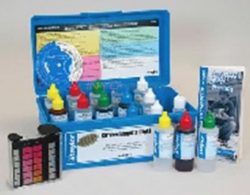 In the test, if your free chlorine reading matches your total chlorine reading, your pool is NOT experiencing a high demand for chlorine. This is a normal reading.
In the test, if your free chlorine reading matches your total chlorine reading, your pool is NOT experiencing a high demand for chlorine. This is a normal reading.
However, if your free chlorine reading is different than your total chlorine reading, then there’s a problem. You shouldn’t have a free chlorine reading of 3 and a total chlorine reading of 7.
Breaking Your Chlorine Lock
While there are many ways to solve this issue, we will only be covering a few of them. Please select the option you are most comfortable with.
Partially Draining Your Pool
One of the simplest methods to breaking chlorine demand is by partially draining your pool. The severity of the chlorine lock determines how long this method takes. Unfortunately, there’s no exact science to this. Simply drain your pool little by little, refill it, test it, and repeat if necessary.
Shock Your Pool
Another method of breaking chlorine lock is shocking your pool. Bring your chlorine levels to 20ppm or three times higher than the current levels. We recommend using a non-chlorine oxidizing shock until your free and total chlorine reads the same.
We typically see more pools with a high demand for chlorine during spring opening season. A lot of the times, pools sit for months accumulating a ton of different contaminants. This is one of the reasons we always recommend balancing your pool before you close it. You don’t want to compile pool issues or push them to the side. Although high chlorine demand is more common than you might suspect, it is something pool owners can handle themselves.
Give us a call if you think your pool is experiencing this same issue. Make sure you have your most recent chemical readings before we can offer any help.

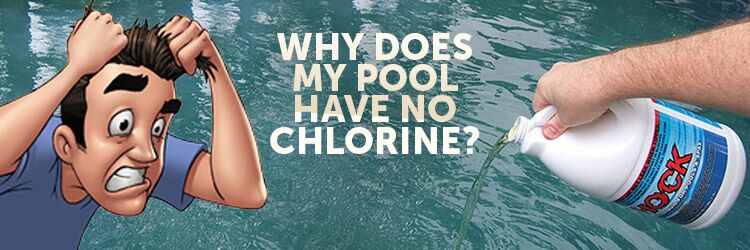

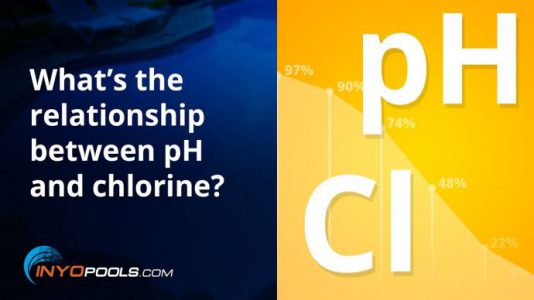
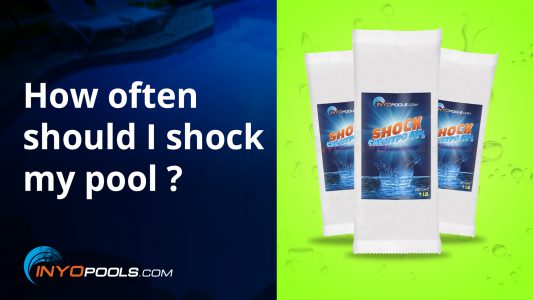
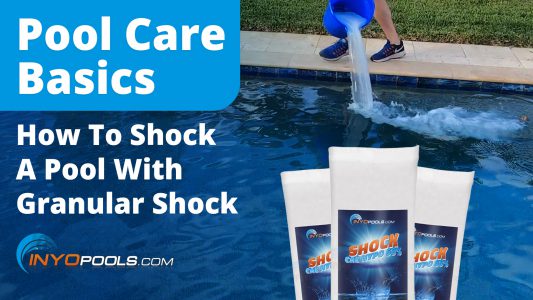






Why is my pool having a level of zero for chlorine after putting in 8 gallons of chlorine?? We have also tried home kits to see if our testing strips are the problem but they read the same.(0 chlorination level) We have tried shock, chlorine tablets, chlorine gallons but nothing is working, any recommendations.
What are the results of your most recent water chemistry test?
Chlorine –
pH –
Alkalinity –
CYA –
Chlorine cannot sanitize your pool chemistry by itself; it requires pH and alkalinity to be in the optimal range for it to be efficient and effective. If your CYA level is too low, the sun will burn off the chlorine before it can affect your water, and too much CYA will hinder chlorine from doing its job.
Also, is your water clear, hazy, or green?
I have the same problem as above, dumping in gallons of chlorine, shocking the pool, everything is within range. PH and alkalinity, CYA. It’s all good. There’s faint algae when after a while of no chlorine added. The water is clear. But I’m having no chlorine reading. So the algae is eating it. I can’t put in the algaecide until the chlorine is in normal range? That’s what I’m finding..
I have a 25,000 gallon inground that has a Frog system chlorinator. Pool itself is 17 years old and we were getting a chlorine lock and a lot of algae with the liner up through two weeks ago. Liner was just replaced with a new one and the water is crystal clear. Zero algae, alkalinity is good while stabilizer is a little low. Problem is: zero free chlorine. Plenty of chlorine, just not “free”. I was told this is a symptom of the Frog system and unless the water goes cloudy, it should be fine…is that true or even partially correct?
Hi there!
New pool owner. Felt like I’d gotten the hang of things over the last couple of weeks. We had a fair bit of rain the past couple of weeks as well. Last Sunday, I did my weekly backwash/rinse/filter duties on my pump, and tested the chems – my original test strips only did chlorine, PH, alkalinity. PH/Alk. are in good ranges, but chlorine showed 0 (pure white in color). So I bought better strips which measure additional levels (free chlorine, hardness, cya, etc.). ALL levels show as being in the desired range for all areas, except chlorine/free chlorine which still don’t show anything (color doesn’t change). I’ve now shocked with liquid chlorine, added three chlorine pucks to a floater and three to the skimmer basket and still 0. Couple days later, added more liquid shock, more pucks – today, still 0. It’s a 12 x 24 oval pool that averages about 6′ of depth overall.
Any idea what I should be doing now? And is this ‘normal’? I know we’ve had some rain, but aside from that, it’s been covered (outside of during shocking), it’s vacuumed, the water LOOKS crystal clear, but the chlorine showing 0 is really confusing to me. Am I supposed to just dump two full jugs of the chlorine ‘shock’ in? I don’t get why the levels had all been perfect up until a week ago, when the only differentiator was the rain. Having said that, I had to drain a fair bit of water (maybe an inch or two) as a result of the rain, which was noticeable due to the water line being above the top of the skimmer outlet/flap.
Just hoping for ‘next steps’.
Thanks so much – really appreciate the help!
Brad
Did anyone respond to this post? I am having the same issue, but not much rain involved. 18×52 and can’t hold chlorine for less than a day. In direct sun for mostof day, crystal clear good looking water. Just did a round of green and clean with 3 lbs chlorine 12hrs apart. 2 days later after last lb and 0 chlorine.
You need to rise your cya up or get it tested. Most new pool owners think you just add tabs and they will do there job. Every new fill or drain you need to adjust the cya up to 30ppm for the chlorine tabs to hold up. Your burning out because there is probably none to support your tabs. Test your water at a local pool store if you have any questions
I had a new liner put in my 24 ft above ground pool and filled it with a hose. In total over a few weeks, I have added ,7 gallons of chlorine and 2 bags of shock plus cleaned the filter twice. Both my chlorine levels are still reading low but water is clear. Is it safe for grandkids to swim in? buzboys99@hotmail.com
I have a 4500 gallon above ground intex pool just opened. Balanced calcium hardness, alkalinity, and ph and then shocked pool with one gallon of liquid chlorine. Next day chlorine and ph were through the roof. I have it some more time and now 24 hrs after shock I have zero chlorine. All other numbers ok but cya low. Should I add stabilizer first and then shock again?? Thanks!
We need test result numbers to give accurate advice. Pool chemistry is not an “exact science,” but it is darn near close, so we need accurate info to tell you how much to add.
Also, you don’t mention adding any stabilizer to maintain the chlorine levels. Chlorine shock does exactly as its name says; it is a sudden burst of chlorine, then dissipates. So if you want chlorine to stay in your pool, you need stabilized chlorine.
Bring CYA to 30ppm, wait 12 hours then shock with a gallon
We have a 40000 liter kidney shaped pool (vinyl) with a sand filter that we opened this spring and have not been able to get a chlorine reading for 2 weeks. The weather has been cool (20 degrees Celsius) and rainy. We have brought pool water samples in for testing numerous times and they are baffled but have suggested several actions over the course of 2 weeks, including 1) back washing 2) removing phosphates 3) shocking 4) cleaning filter sand 5) scrubbing the walls and 6) vacuuming. The water is clear but still no chlorine.
Our latest chemistry readings were:
free chlorine = .69 ppm
total Chlorine = 8.11 ppm
Combined chlorine = 7.42 ppm
PH = 7.3
Hardness= 288ppm
Alkalinity = 125ppm
Cyanuric acid = 13 ppm
Copper = 0.1 ppm
Iron = 0.1 ppm
phosphate = normal
Anything you can suggest? We have a lot of company coming in less than a week and really want the pool to be available.
Thank you for your help.
I just skipped to your CYA levels. That’s why your chlorine is burning off. CYA (stabilizer) prevents your chlorine from being burnt off by UV rays. The stabilizer needs to be in the correct range from chlorine to be able to work effectively and stay active in the water.
Also, use a non-chlor shock to clear out the chloramines. How To Break Chlorine Lock
8404 Gal. 12×24 Intex vinyl pool: Opened pool, used calcium hypochlorite granular shock, & over a few days worked on balancing the Alkalinity & PH using Muriatic Acid. Chlorine from that shock lasted about 15 hours. Added 1 Clorox Pool & Spa XtraBlue 3” tablet in floater to pool, but still 0 Chlorine registered after 24 hours and beyond.
7PM last night: Took Chlorine floater out and Shocked pool, 2nd time in a week.
7AM this morning: Total Chlorine between 4-5 ppm (using my HTH Regent Test Kit). No CYA added at all but I then added Clorox Pool & Spa XtraBlue 3” tablet in floater back into pool, floater window fully open. (I understand the tablets should have stabilizer in them and that is why I hesitate to add CYA). Came back out at 12:30PM to check chlorine level and was shocked to see it back at 0 or not registering. I did a CYA test and it is 0 (now I’ve used up my CYA test, kit only allows for 2 tests).
Water looks clear and beautiful. We have not swam in it and will not until chlorine is right. Pool is clean, algaecide used for preventative, clarified, and vacuumed.
Current Readings-
Alkalinity: 120
PH: 7.3
Total Chlorine: 0, not registering
CYA: 0, not registering
Hardness: 200
*My HTH Regent Test Kit does not have a test for Available Chlorine, but I imagine if Total is 0 then Available would be 0.
I’m not new to pool care but this is my first year trying chlorine tablets. (Have done Bromine, Power Ionizer, and Salt chlorine generator for pool sanitation at different times in the past.)
I now have a tablet in the floater and 1 in the skimmer in hopes of seeing some yellow show up in my chlorine test.
Am I doing something wrong, and what should be my next step?
How long is a reasonable wait to give chlorine tablets time to register?
When I view the tablets, I see no evidence whatsoever of any dissolving. Maybe I’m being impatient but I’m starting to feel frustrated.
I’ll be honest with you, I skipped most of this long post and went straight to your CYA levels. You have 0 CYA which means your Chlorine has 0 protection from being burnt off from the sun. Chlorine is useless when the other water chemistry is useless is completely out of whack.
Get your CYA levels to 30 ppm by adding a stabilizer. Once the CYA is in place add pool to boost the chlorine and have the chlorine tabs in your choice of the chlorinator. The shock will do most of the heavy lifting while the chlorine tabs are dissolving.
My Mechanical chlorine feeder is reading a -0.14 What does this mean!
What is the make and model or model number of the unit? We need to know what it is, to understand what type of reading it would output.
Have a large inground kidney shaped pool prob 25-30k gal. I opened it up this year and have had the pump running for the week and back washed a few times. I have dumped 20 bags of shock into the pool and it still reads 0 chlorine. I don’t know why this is happening but the color is looking almost clear now. I know I don’t have a solar cover and this week has been 90+ and sunny so that has impacted it. But why would 20 bags of shock read zero when all the other numbers are great. The local pool guy tells me to keep shocking it.
Did you balance the water chemistry before adding all that shock? Chlorine shock is a powerful chemical, but you deaden its effectiveness if you don’t balance the water’s pH, alkalinity, stabilizer (CYA), and calcium hardness. Just regarding CYA, it’s called chlorine sunscreen because it protects chlorine from being burnt off by the sun. If your CYA levels are too low, the sun is burning off chlorine during hot days before it can do anything to affect your pool.
I shocked my pool and now chlorine level is showing as 0
Do I now add more chlorine before I swim or will the chlorinator do that? When is it safe to swim?
If the chlorine level is zero, it doesn’t sound like your chlorinator is doing its job. It is safe to swim with active chlorine in the pool, below shock levels.
Provide the full results of your most recent chemistry results. Chlorine is affected by the other chemical components of your water. We need to know the complete picture to try to suss out a solution.
Ok. I am beyond frustrated. New pool owner. My wife is supposed to be handling the chemicals. But it looks like I need to take over. 18×33 (~14000 gal)above ground pool installed 7/5. It probably wasn’t started correctly. This is supposed to be a saltwater pool. Since day 1, we never really had much chlorine showing. The salt generator (Saltron Retro) doesn’t seem to be generating chlorine or working correctly. The indicator on it says salt is low. She added 10 bags originally and then another 3 to the indicator to not read low. Now pool store says salt is high. We are temporarily giving up on the salt gen and trying to get some chlorine (using liquid chlorine)in the pool before it turns green or something. Have noticed a slight bit of sliminess on the walls. CYA was low up until yesterday thanks to 5lbs of stabilizer. Added half a gallon last night with no results so added another half this morning. Still no free chlorine. Current readings are…total Chl-0, free chl-0, ph-8.4ish, Alk-240. What should be the next steps? Please help and explain so a 5 year old can understand. Lol. Thank you
After an entire gallon of chlorine within 24 hours I’m surprised there is none showing
There is no surprise here; your water chemistry is preventing your chlorine from holding its ground. The CYA, pH, and alkalinity are all essential to allowing your chlorine to work efficiently and effectively. Putting any more chlorine into that pool before the pH, alkalinity, and CYA levels are resolved is wasting money and chemicals.
Do you have chemicals to adjust these water balancers? How To Maintain A Swimming Pool Part 1 (Chemicals)
You could have left the comments about your wife out of this. They were not necessary to the question about pool chemicals.
Amen!
I agree, Sarah.
It was essential as she was not doing the job correctly so he needed to take over. What’s the big deal? If it were the other way around, all of you same people would be applauding her.
seriously!
you could have minded your own business!
😂. Aww you poor thing.
I’m sure you are BOTH doing the best you can with the knowledge you BOTH have.
I have had a salt pool for 8 years. If the chlorinator is not working properly it will call for more salt. I have learned the hard way not to believe the machine. After adding bags and bags, like you did I too took a sample to the store only to find out that I had over salted it. Conclusion, when the machine says low salt it usually means that you need a new chlorinator. Over salting is hard to over come. Here is Texas we were in stage 5 drought so I couldnt run up my water bill draining the pool and refilling it. That winter, I hooked up two rain barrels with spigots to the gutters on my house and put every bit of rain water I could in the pool. By the next summer it had deluded it enough for the new chlorinator to read the salt content correctly—but it was still high—-6000. You can just put store bought chlorine in your pool for a while because the chlorinator will not work if the salt is too high.
Thank you for sharing your experience. But I disagree with “check salt” light, meaning you must replace the cell. The check salt salt is one of the more common alerts you’ll get from any salt system. If a new cell was needed every time the check salt light was lit, you’d need a second mortgage.
The check salt light is usually an indicator that the cell needs to be cleaned or the control needs to be recalibrated. The options are cheap, if not free, routine maintenance.
My current method of fixing my money pit…I mean “pool” is a bulldozer.
How’d the fix go? Please, fill us in.
Hahahahaha
🤣
Amen. Wish I didn’t have a pool.
Hi,
I’ve got one of those Lazy spa hot tubes, 850l and when reading PH levels for 15 seconds it shows normal, but after one minute it goes to High. Is this normal? I need to daily check the levels of chlorine because it is always low and need to add more.
Cheers,
Vini
I added 5 3inch chlorine to skimmer yesterday and my chlorine level is 0 today….is this normal
I assume you’ve recently opened your pool. My advice would be to zap it with a heavy dose of liquid chlorine. Very heavy. I have a 24000 gal pool and when I open in the spring I add 5 gallons. For me trying to get away with 2.5 will not work – I get a strong reading and it gets eaten up in a day or 2. Go heavy or it will end up costing you more. After I do that I can go to my regular dose of 2 (sometimes 3 if it’s really hot) 3” tablets.
I also like the idea of really getting it chlorinated when you open it to make sure it’s sanitized.
I have a 24 ft above ground pool. All of my levels are in a normal range except for my chlorine. I can’t get any readings. The pool looks great. Any advice would be so much appreciated.
We are currently have an issue with Algae growth in our pool and noticed our pool company has been treated the pool with a type on granular substance that sits on the bottom of the pool. This substance has now bleached out the color of our new liner that was placed in April. When I questioned the company they said the granules would not do that . Every weekend our pool is green with algae growth. I have since tested the pool water twice and both times the readings show. Zero levels for -total, free and combined chlorine. The ph was 7.8 stabilizer 80 ppm. Total alkalinity was 240ppm and 200 ppm. When I questioned the company about these readings they sent a new technician over . He told me I had a chlorine lock ! I pointed out the discoloration in the liner and he said he would question the other tech. Later that day I got an email stating they are canceling my service. Two questions Do I have a chlorine lock? And did the granules they added cause damage to my liner?
Yes that will ruin your liner not only is it bleaching it it is making it thin in those areas too
So there are several things I would need to clarify before a solid recommendation could be made on fixing your balance issues. I assume with a new liner that it is vinyl lined, is it above ground, or in-ground with plaster or concrete surrounding the pool? (This will dictate calcium hardness requirements) What type of filter are you using, sand or cartridge? And I assume you are not using a salt water chlorine generator with using tabs.
Are your readings correctly listed? Total alkalinity and stabilizer (cyanuric acid) are way too high. To bring the stabilizer down, the best thing to do is partially drain and fill until stabilizer is down to 30-35. If your alkalinity is over 200, you’re going to need a lot of muriatic acid. Do the stabilizer balancing first, this may reduce the alkalinity work. I would imagine that you are chasing your pH with it climbing to 8 really fast. Getting alkalinity down to 80 will help with the pH bounce. Add the acid until the pH gets down to 6.8, usually no more than a gallon at a time. Then point your return jet up to agitate the surface water to bring the pH up without chemicals (VERY IMPORTANT – do not use chemicals to bring up pH, it will negate the acids work on reducing alkalinity) When the pH is up to 7.2 or more, test alkalinity and repeat if still above 90. When alkalinity is balanced and pH of back to 7.2, you’re ready to start. If algae is still visible, backwash your sand filter out clean your cartridge very often. KEEP THE FILTER RUNNING 24/7
Next is calcium hardness, it will probably be low. For an above ground, it’s not that critical but needs to be above 200, ideally 250. Keep filtering
Now you’re ready to shock the crap out of the pool to kill all algae. Scrub the walls and floor before adding liquid bleach to get chlorine way off the charts at 30ppm. Keep filtering and wait for the levels to come down to under 5. Recheck alkalinity and pH during this process and adjust as above.
Now this next part is my recommendation and others will argue, but it has always worked for me. With your chlorine back to 3 and other readings balanced, add Weekly Pool Perfect, available from Leslie’s. It will reduce phosphates, clarify and floc the cloudy particles down to the bottom of the pool for vacuuming. My pool went from cloudy to crystal clear in less than 48 hours after the first dose.
Then maintain chlorine at 3ppm and shock weekly. If your using stabilized chlorine (dichlor or tricolor) your stabilizer level will go up over time. High stabilizer will lock up your chlorine, making it expensive and ineffective to maintain chlorine levels. If you use stabilized chlorine, it will only make the stabilizer level higher. Use calcium or sodium hypochlorite to shock to help prevent this rise.
Lastly, get an attorney. That pool company damaged your new liner and are incompetent to allow your alkalinity to remain that high, add chemicals ineffectively and let the problems persist. The word negligent is defined by that practice. I hope this helps. Plan on this process taking a couple of weeks. A complete drain and fill may be quicker, but will still need to be balanced as above, it just may not need the superchlorination to kill algae if the pool surfaces are cleaned very well after the drain.
Nice!
Hi, hoping for some advice…
We have a 10 x 6 ft pool, cya lvls very high which has impacted on chlorine lvl (0). Ph fine at 7.6 and alkaline also OK. Pool being used daily. I use 200g multifunctional tablets in floating dispenser on setting 2.
I Just bought a submersible pump to help drain half the water and to get rid of the cya issue.(fingers crossed)
The pump cartridge is also really struggling, I’m having to change it every day even though the pool has been vacuumed weekly /skimmed daily etc.
My question is how much chlorine Granules should I use to shock the pool once I’ve drained /replaced half of the water. I used 18g to get to 2ppm but no affect previously.
Any advice about the cartridge would be great too. (530g/h) been using a filter sock last few days which has been great to ease the pressure on the pump.
Just make sure to rinse that filter every day and shock once a week try a water test if chlorine levels are low use chlorine shock if not use non chlorine shock and use a pool cover at night I recommend a water proof cover and scrub the pool walls everyday once morning or night and use a skimmer hand held or electric to clean the leafs and debris out of the water and check Ph of the water 💦. Do not over chlorinate or too little use that pool test kit ! Hope this helps.
If you’re clogging your filter that often, I would use a floc agent to settle the particles to the bottom. Then vacuum to waste. Since cartridge filters to not have this option, configure your submersible pump to pull from your vacuum so you can get the settled particles out with your drain work.
How do u do the vacuum part
just put up a brand new above ground pool.We can’t get any readings on the chemicals we’ve added…what good be the problem ? Frustrated
I suggest using Inyo’s My Pool Dashboard to calculate how much of each chemical you will need to balance your water chemistry. You’ll need to enter your pool size and the results of an accurate water chemistry test.
We just had all the leaks fixed, terrible algae problem before that. And our pool lady is upset saying we still must have a leak because our readings have been the following for the last 2 weeks..
250 ppm hardness
0 free chlorine
0 total chlorine
120 ppm total alkalinity
She added…both weeks
3 chlorine tabs to skimmer
8 lbs shock
Is our pool still leaking or do we need a new pool lady?!! We’re in northern Florida at 95 temps. Water is crystal clear and only dropping maybe 1/4 inch per day at most.
What is your stabilizer (CYA) level? How long do the three tablets during the week? Are they completely gone within a couple of days or are there remnants by the time the company comes back around?
It doesn’t sound like a water leak to me, 1/4″ evaporation rate is standard.
I have a 16 by 36 I ground pool. On Tuesday, our pool was very cloudy with a 0 free chlorine reading. I had my suspicions it was phosphates and it was tested and confirmed. I put in phosfree to get rid of them. Threw my robot in the pool. By Thursday it was clear but still no reading of free chlorine. The guy tested my water said everything looks good but to add 20 bags of shock, which I did. Today still no reading of free chlorine. He said when he tested my water the phosphates were in a the 900’s. He did an actual phosphate test but it took
About two to three minutes for it to turn blue. They told me the phosphates aren’t my problem. What do you think? I am going to take out my filters and clean them today. I don’t need Algae blooms to start.
I hope you meant 2 bags of shock; 20 bags of shock would be crazy unless the pool is 200K gallons. What is your CYA level? What other chlorine are you using besides shock? Shock is great for a boost but it cannot sustain your chlorine levels. You need to use a stabilized chlorine that can stay in your water, then your chlorine levels will improve.
I have an 18 foot x 4 above ground pool. Last week the water started to get cloudy. I tested it and learnt that I had too much cyranic acid in it. They recommended I drain 60% of the pool. So, I drained about 80%. The pool filled overnight. This morning I have 0 free chlorine and the pool is still a bit cloudy. Alkalinity is at 80 and pH is low. What do I do? Thank you in advance!
I have the same problem a 25,000 gallon concrete inground pool not holding chlorine phosphates have been treated with Foss free latest reading was 2000. Cleaned the filter, Pool company advised me to add 7 pounds of shock which I did. The water is sparkling and beautiful but it still will not register chlorine he said I might have nitrates which is worse than Phosphates. I plan to have it tested for that, Any feedback or comments would be highly appreciated
What are your latest water chemistry test results?